Tokonoma and Imae
In Chanoyu, when the tei-shu, 亭主, house-master, is planning a full Tea gathering, Cha-ji, 茶事, Tea-matter, or cha-kai, 茶会, tea-meeting, perhaps the first thing is to choose a kake-mono, 掛物, hang-thing, that is appropriate for the occasion. If one is fortunate to have a wide variety to choose from, the choice can be challenging. If there is simply one in the collection, it will do. The scroll is hung in the toko-no-ma, 床の間, floor-’s-room, alcove. When a guest enters the Tearoom, he or she goes directly to the tokonoma, and sits in front of it to look at the scroll. The teishu is the only person who may actually enter the tokonoma, except for special occasions.
When the guests are assembled, the teishu opens the door leading from the preparation room into the Tearoom, the shō-kyaku, 正客, main-guest, invites the teishu to enter the room. The shōkyaku asks the teishu to read the writing on the scroll, or describe its content.
When making Tea for the guests, the teishu sits in front of the displayed Cha-dō-gu, 茶道具, Tea-way-tools. The most formal direction faced by the host, teishu, is when using the fu-ro, 風炉, wind-hearth, and facing north, the seat of deity. In the ideal yo-jō-han, 四畳半, four-mat-half, cha-shitsu, 茶室, tea-room, the toko-no-ma is in the north toward the east.
The tokonoma in this arrangement on the right side of the ‘north’ wall is called a jō-za-doko, 上座床, upper-seat-floor: the toko-bashira, 床柱, floor-post, is on the left side of the tokonoma. This may also be called hon-ga-tte, 本勝手, true-prevail-hand. When the tokonoma is located on the opposite or the left side of the ‘north’ wall, with the toko-bashira on the right side, is called a ge-za-doko, 下座床, down-seat-floor. This may also be called gyaku-ga-tte, 逆勝手, opposite-prevail-hand.
The tokonoma is half the width of the north wall, and the toko-bashira, 床柱, floor-post, divides the wall. In a way, the tokonoma is part of half of the Tearoom where the guests, kyaku, 客, sit; in the east half of the room. Directly in front of the teishu is a blank wall, a concept which may evoke the custom of Buddhists who face a blank wall when meditating in za-Zen, 座禅, seated-Zen.
The origin of the deity located in the north is with reference to the North Star, Polaris, Ho–kkyo-sei, 北極星, North-extreme-star. The universe appears to revolve around the pole star, which is more clearly identified by its relationship to the constellation of the Big Dipper; Hoku-to-shichi-sei, 北斗七星, North-measure-seven-stars. These seven stars are the inspiration of the innumerable groups of seven, such as the Shichi-fuku-jin, 七福神, Seven-fortune-gods, Rikyū’s nana-shu futa-oki, 七種蓋置, seven-kind lid-places, haru no nana-kusa, 春の七草, spring ’s seven-grasses, etc.
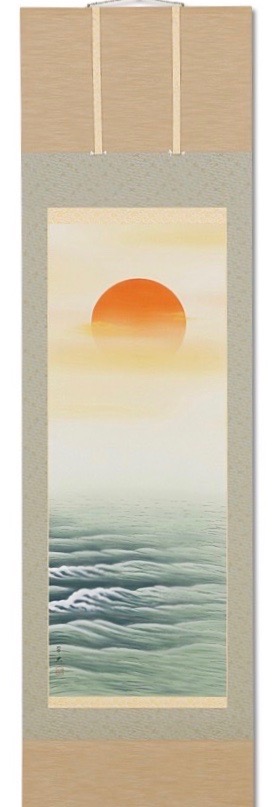
Kake-jiku, 掛軸, hang-scroll, with an image of the red sun rising in the east out of the sea, the origin of the name for Japan, Ni-ppon, 日本, Sun-origin. A scroll such as this, would be displayed in the tokonoma on New Year’s morning, Gan-tan, 元旦, Origin-dawn. Gantan is the source of Sen Rikyū’s grandson’s name, Sō-tan, 宗旦, Sect-dawn, as he was born on the first day of the year, 1578. It was a Tora-doshi, 寅の月, Tiger year, and 2022, a Tiger Year, was the 444th anniversary of his birth. Sōtan died in 1658, at age 80. On the 19th of November, Urasenke observes Sōtan-ki, 宗旦忌, Sect-dawn-memorial, the anniversary of the death of their great patriarch Gen-paku Sō-tan, 元拍宗旦, Origin-uncle Sect-dawn.
The sun rises in the east, however, it is the earth that is turning. The sky does not turn, but appears to turn because of the rotation of the earth. The sun, moon, planets, and stars appear to rise in the east, and set in the west.
This aspect of the universe changes throughout the year because of the tilt of the earth’s axis. The Pole Star location is not fixed either, as throughout the centuries it moves in an extremely slow process called procession. The yojōhan chashitsu reflects the ideal state of the relationship between the earth and the heavens.
When presenting Tea, whether using the furo or the ro, there are three positions that the teishu takes: i-mae, 居前, be-before, facing the utensils directly, kyaku–tsuki, 客付き, guests-attach, facing in the general direction of the guest, and ka-tte-tsuki, 勝手付き, prevail-hand-attach, facing away from the guest and theoretically toward the mizu-ya, 水屋, water-house, preparation room.
During the standard furo presentations of Tea, the cha-ki, 茶器, tea container, and cha-shaku, 茶杓, tea-scoop, and other utensils may be presented to the guests. Often, it is the shōkyaku who requests to see the utensils, which is called hai-ken, 拝見, worship-see. The teishu, with the utensil, turns kyaku-tsuki, toward the guest, purifies the utensil and presents it to the guest, placing it on the adjoining tatami.
The direction of kyakutsuki is toward the near corner of the adjoining ki-nin–tatami, 貴人畳, noble-person-mat. Ideally, the teishu should sit back 8 sun kane-jaku from the tatami heri, 縁, binding. This kyakutsuki direction continues to the northeast corner post of the yojōhan. This post is primarily identified with Ri-sshun, 立春, Start-spring, and Ko-kū-zō Bo-satsu, 虚空蔵菩薩, Empty-void-keep Grass-buddha, the divine embodiment of the vastness of Buddha’s wisdom. The northeast corner post of the yojōhan is also in many instances, a corner post of the tokonoma. The kyaku-tsuki direction with furo is the same as the soto-zumi, 外隅, outer-corner, of the ro-buchi, 炉縁, hearth-frame, when using the sunken hearth to present Tea.
In the realm of Chanoyu, there is the possibility that there are seven directions of i-mae, 居前, be-fore, taken by the teishu in the Tearoom.
When beginning the study and practice of ten–mae, 点前, offer-fore, using the sunken ro, 炉, hearth, the teishu i-mae, 居前, be-before, aligns the center of the body with the near left uchi–zumi, 内隅, inner-corner of the ro-buchi, 炉縁, hearth-frame.
Furo nagashi-date, 流し点, flow along-offer, imae is aligned with the left side of the mizu-sashi, 水指, water-indicate, vessel that is placed nearby on the adjacent corner of the ki-nin tatami, 貴人畳, noble-person mat. Ro nagashi-date imae is with the teishu facing the ro directly on the adjacent tatami, aligned with the center of the kama, 釜, kettle.
Ro-buchi, 炉縁, hearth-frame, uchi-zumi, 内角, inner-corner, imae is directed toward the 7th day of the 1st lunar month. The 1st lunar month corresponds to the sign of the Tora, 寅, Tiger, and its Buddhist guardian, Ko-kū-zō Bo-satsu, 虚空蔵菩薩, Empty-void-keep Grass-buddha. There are three important events on the 7th day of the 1st lunar month. Han-getsu, 半月, half-moon. Haru no nana-kusa, 春の七草, Spring’s seven-grasses. Jin-jitsu no Se-kku, 人日の節句, Human-day ’s Divide-season, is one of the five seasonal festivals that were from China, and integrated into the Japanese imperial calendar over 1,000 years ago.
In the creation of the world, it is thought that on 7th day, human beings were created. In the Judeo-Christian belief, Adam and Eve were created on the 6th day. In time, people sought fortune telling for the New Year. Haru no nana-kusa, 春の七草, Spring’s seven-grasses, are seven medicinal herbs that are pounded and mixed with a rice gruel, nana-kusa-gayu, 七草粥, seven-grasses-gruel, to help clear the system of the heaviness of winter’s root vegetables. This Japanese event was incorporated into Jinjitsu.
Ro-buchi, 炉縁, hearth-frame, soto-zumi, 外角, outer-corner, i-mae is directed toward the northeast corner post of the Tearoom. This corresponds with Ri-sshun, 立春, Start-spring, which is one of the 24 seasonal divisions of the solar year. It theoretically corresponds with the 1st day of the 1st lunar month.
There is a familiar expression, Risshun Dai-kichi, 立春大吉, Start-spring Great-joy, which is written on a pieces of paper and posted near the front door, and elsewhere. Risshun begins the lunar Tora no tsuki, 寅の月, Tiger’s Month. The eve of Risshun is Setsu-bun, 節分, Season-divide, the last day of Winter.
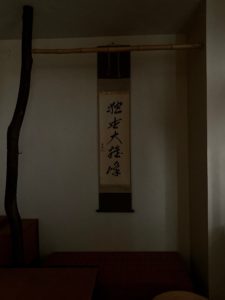

One day, a monk asked abbot Hyakujō, “Ichi ban tottoi no mono wa nan-desuka?” 一番貴いものは何ですか, One-number precious thing is what? Hyakujō replied, “Doku-za Dai-yū-hō.” 独坐大雄峰, Alone-sit Great-hero-peak. Hyaku-jō E-kai, 百丈懐海, Hundred-ten shaku Heart-sea, Baizhang Huaihai (720?-814?). Hyakujō is the name of the mountain where his temple was located.
The ideal kakemono for a Tea presentation is an ichi-gyō-mono, 一行物, one-line-thing, which is composed of five Kanji aligned from the top to bottom of the scroll. The number 5 is an extraordinarily symbolic number, which may have its origins in the human body: the five fingers and toes, the five senses, etc. There are five physical elements called Go-gyō, 五行, Five-transitions: Earth, Water, Fire, Metal, and Wood. There are their counterparts, the five principles called Go-rin, 五輪, Five-rings: Earth, Water, Fire, Wind, and the Void.
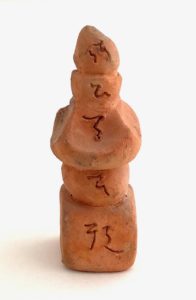
The verticality of the Kanji is emulating the Go-rin-tō, 五輪塔, Five-ring-tower, that is a stone monument to the immortal soul.
In Buddhism, there are the essential modes of conduct espoused by Daruma called the Go-kai, 五戒, Five-precepts, which are prohibitions against killing, theft, sexual misconduct, lying, and intoxication. Although the five Kanji of a kakemono are not specifically equated with the five precepts, they are simply five characters.
The ideal tokonoma has three walls that have specific widths that total 9 shaku kane-jaku. The distance from the toko-bashira to the corner post and halfway to the center of the back wall is the middle or fifth shaku. In the center of the space is the take-kugi, 竹釘, bamboo-peg, upon which the scroll is hung. The location of the take-kugi corresponds with the 8th day of the 12th lunar month, the day of Buddha’s Enlightenment. Daruma, like millions of Buddhists, followed the Buddha’s path of enlightenment through meditation, including the Five Precepts.
When the kakemono is rolled up, the kake-o, 掛紐, wrap-cord, is wound five times, go-kai, 五回, five-turns, around the scroll. I believe that this refers specifically to the Buddhist Go-kai, ごかい, Five-precepts.
For a Cha-ji, 茶事, Tea-matter, when the guests enter the Tearoom for the first time, sho-iri, 初入, first-enter, the Tearoom and the tokonoma are dark. Sen no Rikyū’s yo-jō-han, 四畳半, four-mat-half, Tearoom has two windows; one in the east wall and one in the south wall. During the first half of a Chaji, the windows are covered on the outside with reed sudare, 簾, blinds, which are removed for the go-iri, 後入, latter-enter, when Tea is presented.
In the darkened room it is easier to see when the kake-mono, 掛物, hang-thing, is displayed in the tokonoma, a scroll has a black image or calligraphy on white paper. Old scrolls often have darkened and faded images that are precious, but may be difficult to see and read. Perhaps the installation of electric lights in the tokonoma, defeats the intention of actually looking to see. The path through the ro-ji, 露地, dew-ground, garden is laid out in a meandering way, so that one must seek the way. Rikyū’s tokonoma did not have windows. It was Oribe who first put a window in the tokonoma.
In a Chaji, the intention of the hanging scroll is to teach and inspire. It is as though the words or an image, such as that of Daruma, are given by a teacher. When one sits in front of the tokonoma, bows and maintains the posture with the hands on the floor in respect, it is as though one is greeting one’s teacher.
Scrolls that are hung in the tokonoma for a Tea presentation are ideally words that are found in Buddhist scripture. The shōkyaku asks the teishu to read the words written on the kakemono. The words do not exist unless they are spoken aloud. The spoken word is heard, but it has no discernible form, and so is identified with the aspect of Yō, 陽, positive. During the naka-dachi, 中立, middle-stand, when the guests have left the Tearoom, the scroll is removed, and is replaced by a flower held in a water-filled hana-ire, 花入, flower-enter. The flower and water are physical things, and therefore embody the aspect of In, 陰, negative. The flower is the physical manifestation of the intangible word.
When one enters the tokonoma, one should step in with the left foot first, and step backward with the right foot first. In Japanese culture and tradition, one enters a sacred space with the left foot first, and exits with the right foot first. When entering a non-sacred space, one steps in with the right foot first, and leaves with the left foot. In the Urasenke tradition, one enters the Tearoom with the right foot, and leaves with the left. An exception to this is when entering a Tearoom that is gyaku-ga-tte, 逆勝手, reverse-prevail-hand, one enters with the left foot, and leaves with the right.
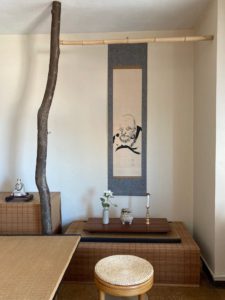
An incense burner is placed in a tokonoma most often during a ritual; however, incense should be burned in the hearth for the spiritual enjoyment of the guests. Incense has no discernible physical form, which is an aspect of Yō, 陽, positive. The absence of a kōro in the tokonoma, affirms the non-physical aspect of Yō.
When a scroll with a picture of Daru-ma, 達磨, Refine-polish, is displayed in the tokonoma for a Tea presentation, the room, by Daruma’s ‘presence’, may be regarded as a Daruma-in, 達磨院, Daruma-sub-temple. A picture of Daruma is in keeping with the familiar concept of “Cha Zen ichi mi,” 茶禅一味, Tea Zen One Taste, because Daruma cut off his eyelids to prevent sleep, and where they landed on the ground, tea plants grew up.
When entering a chashitsu, one goes directly to the tokonoma to see what is displayed within it, which is most often a kake-mono, 掛物, hanging-thing. One regards with great respect the writing and or picture drawn on the scroll. The writing is quite often drawn from Zen Buddhism, and written by a priest of a temple.
Daruma is known for introducing to China a kind of meditation that was called Chan, and later known in Japan as Zen, 禅. Daruma’s meditation procedure centered on sitting for nine years in a cave facing a wall, which is called, men-peki, 面壁, face-wall. This mode of meditation has been long established in many Zen temples around the world.
Daruma is identified with the Buddhist law, 法, dharma, as manifest in the Hō-man-da-ra, 法曼荼羅, Law-wide-weed-spread, which is also known as the Daruma Mandara.
The floor of the tokonoma measures 4.5 x 2.25 sun kane-jaku, which can be divided into two squares 2.25 x 2.25 sun. The measurement of 2.25 sun kane transposed to kujira-jaku is 1.8 sun kujira-jaku. The dimension of 1.8 sun is also 18 bu kujira-jaku. The number 18 can be divided into two 9s. The two 18 by 18 squares may be identified with the Ryō-kai-man-da-ra, 両界曼荼羅, Both-worlds-wide-weed-spread. The front of the two mandala is composed of six units, the number 6 is symbolic of Infinity in Time. The two squares of 9 squares total 18, and 18 times 6, is 108, hyaku-hachi, 百八, hundred-eight, which are the human desires that must be dispelled.
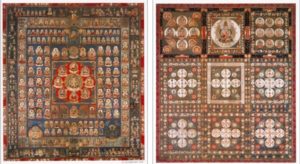
The Ryōkai-man-da-ra is composed of the Tai-zō-kai Man-da-ra, 胎蔵界曼荼羅, Womb-keep Wide-weed-spread, and the Kon-gō-kai Man-da-ra, 金剛界曼荼羅, Gold-strength Wide-weed-spread. The Taizōkai is centered on an eight-petal lotus, which is sacred to Buddhism, and the number 8 is In, 陰, negative, as it can be divided equally in half. The Kongōkai is centered on a square composed of nine squares, and the number 9 is Yō, 陽, positive, because it cannot be divided equally in half. Because the Taizōkai Mandara is based on the lotus flower, and is identified with In, it may be located on the floor of the left side of the tokonoma where the flower in water in the hanaire is located. The Kongōkai Mandara may be located on the floor on the right side of the tokonoma where the fire-related object, such as the incense container or candle, is placed. In some Buddhist temples, immense paintings of the mandara are laid on the floor, and priests and monks walk on them in active meditation.
One of the important ancient texts describes the realm and influence of Dainichi, and is called the Yu-ga Jū-hachi-kai Yubi-ki, 瑜伽十八会指帰, Jewel-attend ten-eight-gather indicate-arrive. It was translated to Chinese in the 9th century. A similar text is the Kon-gō-chō-gyō, 金剛頂経, Gold-strength-bestow-sutra, which is a description and depiction of the paradise of Dainichi, and in its iconography is filled with images of Dainichi. The near-right corner post of the tokonoma, according to the Ekikyō is identified with southwest, the signs of Hitsuji–Saru, 未申, Ram-monkey, and Dainichi. The floor of the tokonoma is composed of two squares of nine squares each, and may be likened to the Ryōkai Mandara and its equivalent of two squares of nine elements.
Perhaps the floor of the tokonoma is identified with the Ryōkai Mandara, the Kongōkai Mandara on the right half of the tokonoma is the place where the kami-kamashiki and kōgō are displayed. The kami kamashiki has its origins in Rikyū’s kai-shi, 懐紙, heart-paper, which he used to temporarily place the kama when taken from the hearth.
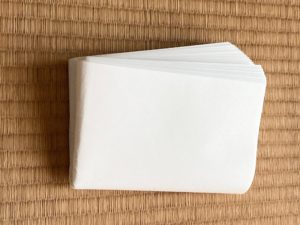
The kami kamashiki are made in packs of various numbers of sheets of paper. A standard is composed of 20 sheets that when folded in half twice, creates 80 sheets. This may have some connection with the Ke-gon-kyō, 華厳経, Flower-strictness-sutra. However, a greater connection might be that the Buddha died at the age of 80.
Ke-gon-kyō is a translation of the Sanskrit Avatamska sutra. It was translated from the Sanskrit into Chinese in the 7th century. The Kegon sutra was later translated into Japanese. Kegon is a metaphor for becoming a buddha. The Kegon Sutra is one of the most influential Mahayana sutras of East Asian Buddhism, and became the name of a sect of Buddhism – Ke-gon-shū, 華厳宗, Flower-strict-sect. Called in English, the Flower Garland Sutra, Flower Adornment Sutra, or Flower Ornament Scripture. The sutra details a cosmos of infinite realms upon realms, mutually containing one another. The Kegon Sutra is written in hachi-jū kan, 八十巻, eight-ten scrolls, called Ya-so Ke-gon, 八十華厳, Eight-ten Flower-strict.
The ideal Tearoom is a yo-jō-han, 四畳半, four-mat-half, and its tokonoma is located on the ‘north’ wall of the room toward the east. The size of the tatami of this type of tokonoma is a 3/4 mat called a dai-me, 台目, support-space, as one quarter of a full tatami is removed. This 1/4 space is identified with the formal display stand called a dai-su, 台子, support-of, which is approximately the size of the tatami on which it would be displayed for a Tea presentation. Such a tokonoma is called a dai-me doko, 台目床, support-space floor.
The location of the tokonoma alcove establishes the north direction, regardless of its actual orientation, as in a geographical map. The tokonoma is located in the northeast for protection from the harsh conditions brought from that direction, which is called ki-mon, 鬼門, demon-gate. Opposite this, located in the southwest corner of the yojōhan is the cha-dō-guchi, 茶道口, tea-way-opening, which is called the ura-ki-mon, 裏鬼門, back-demon-gate.
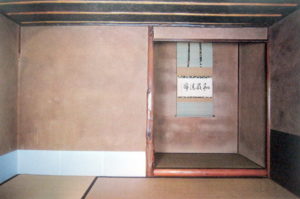
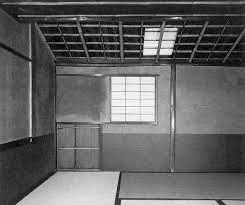
In the Yūin chashitsu, opposite the tokobashira, in the south wall of the room, there is a supporting post, that is slightly off-center. This post may be identified with Ge-shi, 夏至, Summer-attain, the summer solstice, and Sei-shi Bo-satsu, 勢至菩薩, Strength-attain Grass-buddha. Seishi and Kannon accompany Amida Nyorai, who may be located in the northwest corner of the room.
A tokonoma in a Tearoom has a floor that may be made of wood or covered with tatami. The elevation of the floor is created by placing another tatami upon that which exists, and the reason for this is that the tokonoma was intended as a place for a person of nobility to sit, which above others in the adjoining room. This elevated area is called a jō-dan no ma, 上段の間, upper-level ’s room.
The tokonoma is created with four corner posts, with walls on four sides: the front wall is a ko-kabe, 小壁, small-wall, short wall extending down from the ceiling. The height of the ceiling, ten-jō, 天井, heaven-well, is different from the height of the ceiling of the Tearoom.
Having four walls indicates that the toko-no-ma, 床の間, floor-’s-room, is truly a room, and that it is set apart from the Tearoom itself. Although not always present, having tatami on the floor, indicates that it is a place for a person to sit.
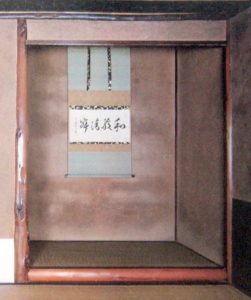
The structure of front of the tokonoma is very like a gate, mon, 門. The Kanji for ma, 間, room, of toko-no-ma, 床の間, is composed of mon, 門, gate, and nichi, 日, sun. The original Kanji, 間, had, rather than the Kanji for sun, 日, had the Kanji for tsuki, 月, moon – 閒. In both instances, the image of the sun and the moon were seen through a gate.
The front of the tokonoma, mawari-buchi, 廻縁, surround-frame, is composed of four wooden members each of which are of different styles. Clockwise from the left: toko-bashira, 床柱, floor-post; natural tree trunk. Ko-kabe, 小壁, small-wall, above the tokonoma opening extending down from the ceiling. Wooden cross member, otoshi-kake, 落し掛け, drop-hang, lintel at the bottom of the kokabe. Corner post at the near-right. Toko-gamachi, 床框, Floor-frame, wood piece covering the front edge of the tokonoma floor tatami.
An essential element of the tokonoma is the toko-bashira, 床柱, floor-post, which is a tree trunk that may have its bark intact, which is to indicate that the post is in fact a tree. The toko-bashira is symbolic rather than structural, as it does not support the roof from the floor.
Depending of the nature the tokonoma, the location of the toko-bashira varies. In a yojōhan, the toko-bashira is near the middle of the ‘north’ wall, with the opening of the tokonoma to the right. The location of the toko-bashira is deemed ge-za, 下座, down-seat. The post usually has a hook imbedded in it to hang a flower container. In the Yūin, Sōtan put the flower hook in the near right post of the tokonoma.
An important aspect of many yojōhan Tearooms, such as Yūin, is that the near right post of the tokonoma, is the northeast corner post of the yojōhan itself. This post is identified with Ri-sshun, 立春, Start-spring. With the changes in the directions of the tokonoma, and the back wall identified with the east direction, the near-right post of the tokonoma is identified with the southwest direction. The post is not only identified with Ri-sshun, 立春, Start-spring, of the yojōhan, but is also identified with Ri-sshu, 立秋, Start-autumn, and Dai-nichi Nyo-rai, 大日如来, Great-sun Like-become, the Buddhist embodiment of the physical universe.
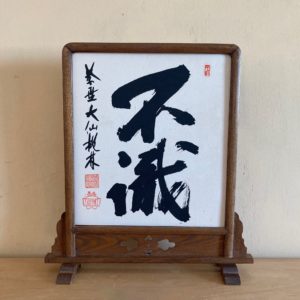
The Tearoom may have a kake-mono, 掛物, hang-thing, with an image of Daruma, which may have calligraphy of a word or phrase identified with him or Buddhism in general. Perhaps his most familiar expression is ‘Fu–shiki’, 不識, No-consciousness, which was his response to the Chinese emperor’s questioning who he was.
Following this event, Daruma went to the Shaolin temple, where he entered a nearby cave, and sat facing a wall for nine years. During this period of meditation, he lost the use of his hands and feet. Troubled by his eyelids closing and tempting sleep, he cut them off so that his eyes were always open. Where his eyelids fell to the ground tea plants grew. Whatever the truth, the tale forever unites tea with wakefulness and meditation. Zen.
This legend prompts endless questioning. One aspect that I have simply accepted without much thought was why nine years? Why nine? This may have connections with his reply to the emperor, fu-shiki, no-consciousness.
Meditation was nothing new to Daruma or Buddhism in general. The Buddha, himself, sought meditation throughout his life. Perhaps the most significant was when he sat on grasses near a tree and meditated for 49 days. Facing east, and upon seeing the morning star, Venus, on the 8th day of the 12th moon, he gained enlightenment, satori, 悟り. This event is called ‘Jō-dō’, 成道, Achieve-way.
The number 7 is a highly symbolic number originating with the importance of 7 stars of the Big Dipper, rotating around the north star, Polaris. The number 49 is 7 times 7. There are Buddhist guardians who preside over specific periods of mourning, who are called the Jū-san-butsu, 十三仏, Ten-three-buddhas. The early periods of time are connected with groups of seven days. The first seven, the second seven, etc. The seventh seven, Shichi-shichi-nichi-ki, 七七日忌, seven-seven-day-memorial, is one of the most important events in Buddhism. The seventh period of seven days is protected by Yaku-shi Nyo-rai, 薬師如来, Medicine-master Like-become, who holds the hō-ju, 宝珠, treasure-jewel, containing the Buddhist elixir of life, kan-ro, 甘露, sweet-dew. Kanro may be identified with tea.
The morning star, identified as the planet Venus, in Japanese is Myō-jō, 明星, Bright-star. The Kanji myō, 明, means wisdom. There are a multitude of aspects of this event that permeate Chanoyu, and one in particular is the tokonoma. The toko-bashira, which, from its appearance, is identifiable as a tree trunk. This could be identified with the Buddha’s tree, called the Bodhi Tree, Enlightenment Tree.
The Bodhi Tree, located in Bodh Gaya in India, is called in Japanese, Bo-dai-ju, 菩提樹, Sacred tree-carry-tree, that has been identified as a sacred fig, and a species of linden. An ancestor of the Buddha’s tree has been an object of worship to this day. The Kanji, bo, 菩, is used in Bo-satsu, 菩薩, Sacred tree- buddha, for Buddhist deities as yet to attain the ultimate nirvana, such as Kan-non Bo-satsu, 観音菩薩, See-sound Sacred tree-buddha, the Buddhist goddess of mercy.
Another aspect of Buddha’s Jōdō is the grasses on the ground upon which he sat in meditation under the tree. The grasses called, kichi-jō-sō, 吉祥草, joy-auspicious-grass, that were given to him by the king of the gods, Indra, Tai-shaku-ten, 帝釈天, Emperor-explain-heaven (deva). The grasses may be likened to the grasses, i-gusa, 藺草, rush-grass, that are used to make tatami that cover the floor of the tokonoma. Taishakuten was present at every major event in the Buddha’s life. Taishakuten resides on the top of the sacred mountain of Shu-mi-sen, 須弥山, Necessary-increase-mountain, Mount Sumeru, which is the center of the world in Hinduism and Buddhism. The mountain is the theoretical model for the Buddhist Shu-mi-dan, 須弥壇, Necessary-increase-altar, that is present in temples dedicated to Amida. It is thought that the sacred Mount Kailash in Tibet is the earthly manifestation of Shumisen.
The cave near Shaolin temple where Daruma meditated for nine years, may evoke a type of tokonoma that is called a hora-doko, 洞床, cave-floor. The sand-finished walls merge seamlessly with the ceiling. An example of this type of tokonoma is at Rikyū’s Tai–an, 待庵, Wait-hut, at Myō-ki-an, 妙喜庵,Wondrous-joy-temple, southwest of Kyōto.
The yojōhan is identified with the months of the lunar calendar, and that also affects the tokonoma. The width of a han-jō, 半畳, half-mat, is 30 sun kane-jaku. This tatami measurement along the perimeter of the yojōhan can be identified with the individual months as well as days. The calendar begins with northeast corner post of the Tearoom, and the start of the first lunar month. The east wall of the room is identified with spring and the first, second, and third months. The south wall is identified with the fourth, fifth, and sixth month.
In the ideal yojōhan for the most formal Tea presentation using the ro, the teishu imae faces the center of the back wall of the tokonoma, the location of the kakemono with its Buddhist wisdom. This is established by the take-kugi that is aligned with the 15th day of the 2nd month, which is protected by Monju Bo-satsu, 文殊菩薩, Literary-exceptional Grass-buddha. Monju, together with Fu-gen Bo-satsu, 普賢菩薩, Universal-wisdom Grass-buddha, accompany the historical Buddha.
The ancient Dai-hatsu-ne-han-gyō, 大般涅槃経, Great-carry-black soil-tub-sutra, preached by the Buddha, is held in Monju’s left hand, the sword of wisdom in his right hand. In Buddhism, the Nirvana Sutra is closely associated with the Lotus Sutra, the Ho-ke-kyō, 法華経, Law-flower-sutra, which seems most appropriate as the lotus flower is identified with the word of the Law. During a Chaji, the hanging scroll of Buddhist wisdom is displayed in the tokonoma for the first part when a meal is served, and is replaced by a flower for the Tea presentation.
Monju figures greatly in a discussion with Vimalakīrti, Yui-ma, 維摩, Rope-chafe, a disciple of the Buddha, who asked Monju how to accommodate the myriads of guests to assemble in his ten-foot square hut. In the yojōhan Tearoom, Monju is located in the east accompanying the guests. Yuima’s hut is thought to be the model for the yojōhan Chashitsu.
In a formal Tea presentation, the teishu imae is focused on the near right corner of the daisu, and is directed toward the take-kugi for hanging a scroll, which is also the place for the flower in a hanging hana-ire. The imae line passes through the center of the left half of the tokonoma where a hanaire may be placed. The imae line also passes close to the toko-bashira, where there is a hook for hanging a hanaire. (See diagram at the end of this article.)
The tokonoma back wall is identified with the three months of spring and east. The posts in the back left corner of the tokonoma is identified with Ri-sshun, 立春, Start-spring, and from this post hangs the New Year’s musubi yanagi, 結柳, tie-willow. The middle of the back wall is the second month, and the 15th day is the exact center, and the location of the take kugi, 竹釘, bamboo-nail. The 15th day of the 2nd lunar month is Jōdōe and Nehan.
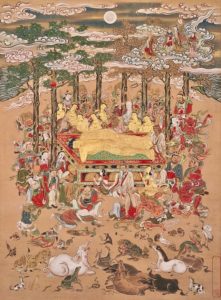
The assembled crowd of mourners includes Buddhist deities, devoted followers, and animals. In the upper right corner of the picture, Maya, the Buddha’s mother approaches from heaven. The picture depicts the locale of the event, the grove of sal trees, the position of the Buddha on his bed with his head toward the north, lying on his left side, looking west toward the paradise of Amida, and the silvery, full moon rising in the east.
When the Buddha was dying, he asked that his bed be placed in the grove of the Sa-ra sō-ju, 沙羅双樹, Sand-spread twin-trees. Upon his death, four of the eight trees died, while the other four flowered. The eight trees symbolize the center of the world. The four living trees may be identified with the four posts of the tokonoma. On a branch of the near left tree is the Buddha’s taku–hatsu, 托鉢, begging bowl, wrapped in cloth. The tree may represent the toko-bashira, and the begging bowl represents a hana-ire, 花入, flower-receptacle, on a hook in the toko-bashira. Buddhists are called Sha-mon, 沙門, Sand-gate, because of the connection to Buddha’s grove of Sa-ra sō-ju, 沙羅双樹, Sand-spread Twin-trees.
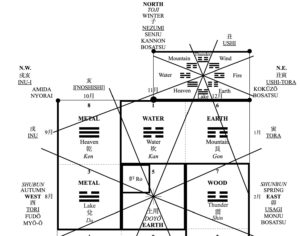
Note that the trigram for Water, Kan, ☵, 坎, Hole, is located from the center of the Tearoom to the middle section of the north wall, and on the left side of the tokonoma. It is in this area that water is present in hana-ire, 花入, flower-receptacle. The trigram for Fire, Ri, ☲, 離, Detach, on the right side of the tokonoma, is the location of a rō-soku tate, 蝋燭立て, wax-lamp stand, and where a kō-gō, 香合, incense-gather, may be displayed. The kōgō contains incense that is placed in the hearth fire.
At times, Sōtan prepared Tea for himself in the Yūin, and put a hook to hang a flower container on the far right post of the tokonoma, so that he was not alone. Sōtan was the first to create a take tsuri-bune hana-ire, 竹釣舟花入, bamboo suspend-boat flower-receptacle, which was named ‘Yoko–gumo’, ヨコ雲, Horizontal-cloud, and is treasured by Urasenke. This flower container was hung from a hook in the center of the ochi-kake, 落掛, lintel at the front of the tokonoma in his Tearoom, Kan-un-tei, 寒雲亭, Cold-cloud-pavilion.
The four kyaku, 客, guests, sit along the east wall of the Tearoom facing west toward the teishu, and the western paradise of Amida. The guests are seated on an area that is marked by the trigram for Lake, Da, ☱, 兌, Exchange. When preparing Tea, the teishu also sits on the area influenced by the trigram for Lake, Da, radiating out from the tokonoma into the Tearoom. Several Buddhist deities are associated with bodies of water.
Kannon is often depicted on a rock above water with the moon in the background: Sui–getsu Kan-non, 水月観音, Water-moon See-sound. The teishu located on the trigram for Lake, is identified with Fudō Myō-ō, 不動明王, No-move Bright-king, who is depicted on a rock surrounded by turbulent waters. The cha-wan, 茶碗, tea-bowl is identified with the trigram for Lake, according to the trigrams of the Eki-kyō, 易経, Change-sutra, and the Ha-kke-bon, 八卦盆, Eight-sign-tray.
The Buddha died and entered nirvana on the 15th day of the 2nd month of the lunar calendar. Were a picture depicting the nirvana of the Buddha to be displayed in the tokonoma, with the full moon rising in the east, the back wall of the tokonoma would be associated, metaphorically, with the east direction. The Buddha was reclining on his bed, toko, 床, with his head toward the north, this identifies the left wall of the tokonoma with the north direction.
An essential aspect of the Eki-kyō, 易経, Change-sutra, is change. The change is often from In, 陰, negative, to Yō, 陽, positive, or the reverse. The tokonoma is in the north wall of the chashitsu, so that the tokonoma is in the north and toward the east. However, when displaying a hanging scroll that has reference to the sunrise of the new year, or the nirvana of the Buddha, the directions of the tokonoma are changed so that the back wall is identified with the east. This affects the placement of the trigrams of the Ekikyō.
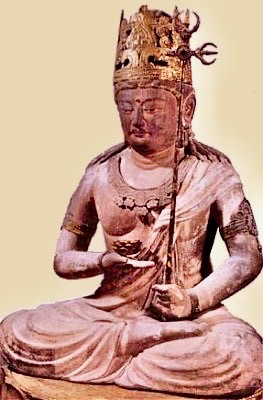
The guests are representatives of zodiac signs and the Buddhist deities who are guardians of those signs, and some of the signs and guardians have associations with water. The shō-kyaku, 正客, main-guest, sits on the area identified with the sign of Ushi, 牛, Ox, which originated with the sacred Indian sui-gyū, 水牛, water-ox, water buffalo. The zodiac sign of the Ushi is protected by Ko-kū-zō Bo-satsu, 虚空蔵菩薩, Empty-space-keep Grass-buddha, who is the spiritual void of the universe. His counterpart is Dai-nichi Nyo-rai, 大日如来, Great-sun Like-become, who is the universe made manifest. In the Tearoom, Dainichi may be identified with the teishu who relates directly with the shōkyaku who may be identified with Kokūzō in the northeast corner of the room.
The second guest may be identified with the sign of U, 卯, Hare, which is associated with the moon, as Asians see a hare in the dark configurations on the moon. The moon has extraordinary power over the seas of the earth, and so does the hare, which is often depicted cavorting over waves. The Buddhist guardian of the sign of the Hare is Monju, 文殊, Literary-exceptional, the embodiment of wisdom. Coincidentally, Monju is the name of a Japanese nuclear power plant that processes water.
The third guest may be identified with the sign of Tatsu, 辰, Dragon, which lives in water, and has the power to bring rain and storms. The fourth guest may be identified with the sign of Mi, 巳, Snake, which is also identified with rain, and can live in water, and is identified with the hō-ju, 宝珠, treasure-jewel, which is an ideological combination of fire and water, un-differentiated In, 陰, negative, and Yō, 陽, positive. The zodiac signs Tatsu-Mi of third and fourth guest are protected by Fu-gen, 普賢, Universal-wisdom, the embodiment of practice. Fugen is associated with a great haku-zo, 白象, White-elephant, and elephants in India are identified with the Buddha, as well as familiars to water. The name of the fabled white elephant, Airavata, who sired the Buddha, is derived from the Sanskrit word for ‘ocean born’. Airavata is the animal vehicle of the king of the gods, Indra; Japanese, Tai-shaku-ten, 帝釈天, Emperor-explain-heaven (deva).

Kake-jiku, 掛軸, hang-scroll, with calligraphy, Mu, 無, No: the Kanji is written with a prominent stroke that suggests the Kanji for ichi, 一, one. To a Buddhist, the Kanji could evoke the phrase, ‘mu ichi butsu’, 無一物, not one thing. The absence of the Kanji for butsu, 物, thing, emphasizes the aspect of no-thing.
The upper section of a hanging scroll is called ten, 天, heaven, and it is divided into three areas. There are no customary loose hanging fū-tai, 風帯, wind-straps, but there are strips of fabric where the hanging straps would be. This technique is called suji-fū-tai, 筋風帯, stripe-wind-strap. Custom and tradition stress the importance of dividing the section identified with heaven into thirds.
It should be understood that the exact center of the main paper with calligraphy or an image should correspond with the mu-sō-kugi, 無双釘, in the center of the back wall of the tokonoma.
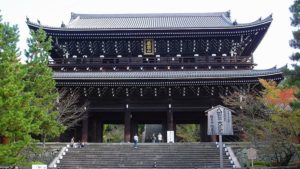
One of the important gates leading to a Buddhist temple, is the San-mon, 三門, Three-gate. This gate may also be called a San-mon, 山門, Mountain-gate, as a Buddhist temple is identified as a mountain. The difference between the Three Gate and the Mountain Gate, is that the Three Gate has three entrances.
San-mon, 三門, Three-gate, Kū-mon, 空門, Void-gate, Mu-sō-mon, 無相門, No-form-gate, Mu-gan-mon, 無願門, No-desire-gate, the way to Satori, 悟, through the three ways, San-ge-datsu-mon, 三解脱門, Three-understand-remove-gate. To remove all earthly desires, attain enlightenment. It appears that the three divisions of the heaven section of the kakejiku may be identified with the three entrances of the Buddhist Sanmon.
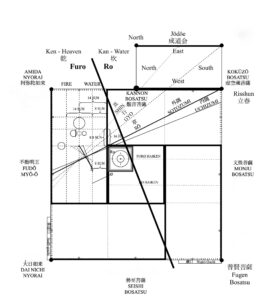
The most formal direction for the teishu is directly north as when using the furo. It becomes less formal the further away from north, which is most common with the de-ro, 出炉, outer-hearth, when the ro is opened in an adjacent tatami. The ro may be opened in the ten-mae tatami, 点前畳, offer-before mat, in two styles: sumi-ro, 隅炉, corner-hearth, and muko-giri, 向切り, opposite-cut, with the ro opened opposite the ro in the corner. When either of these are used, the three imae directions are essentially that same as those used with the furo.
